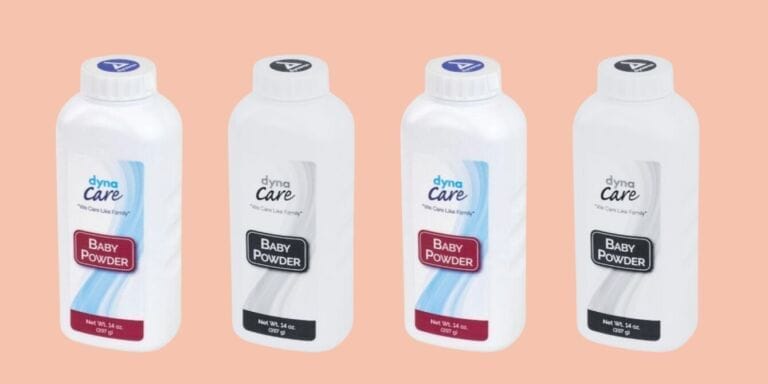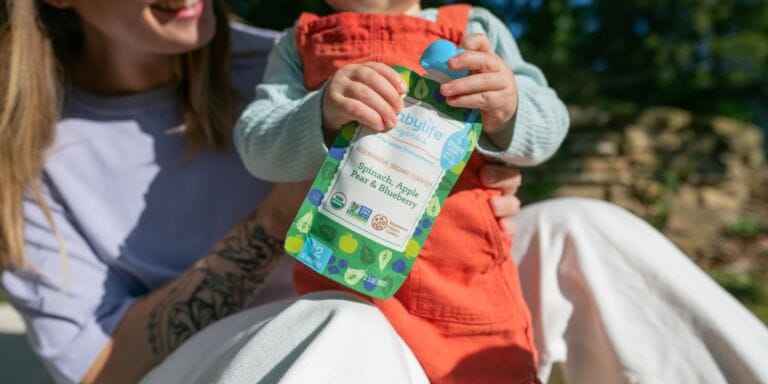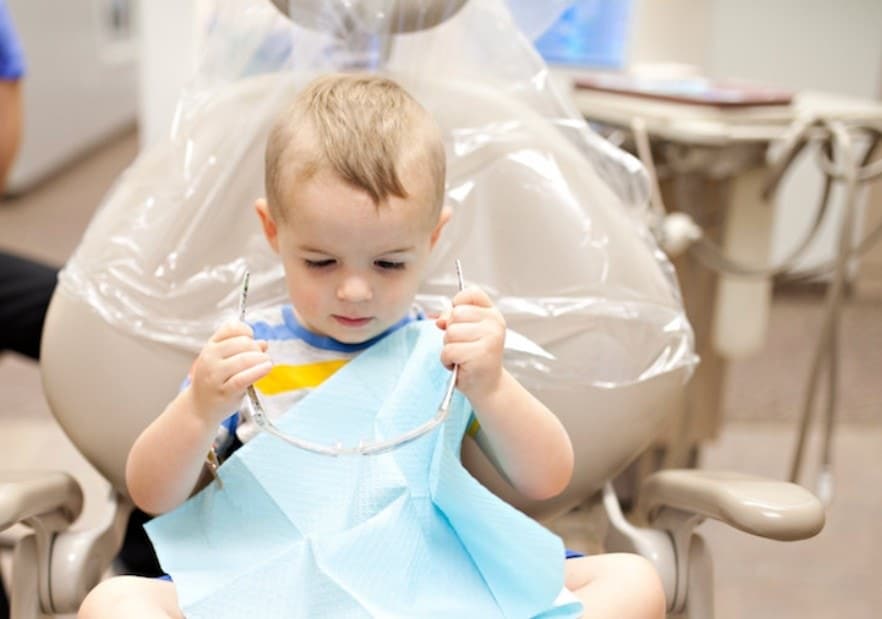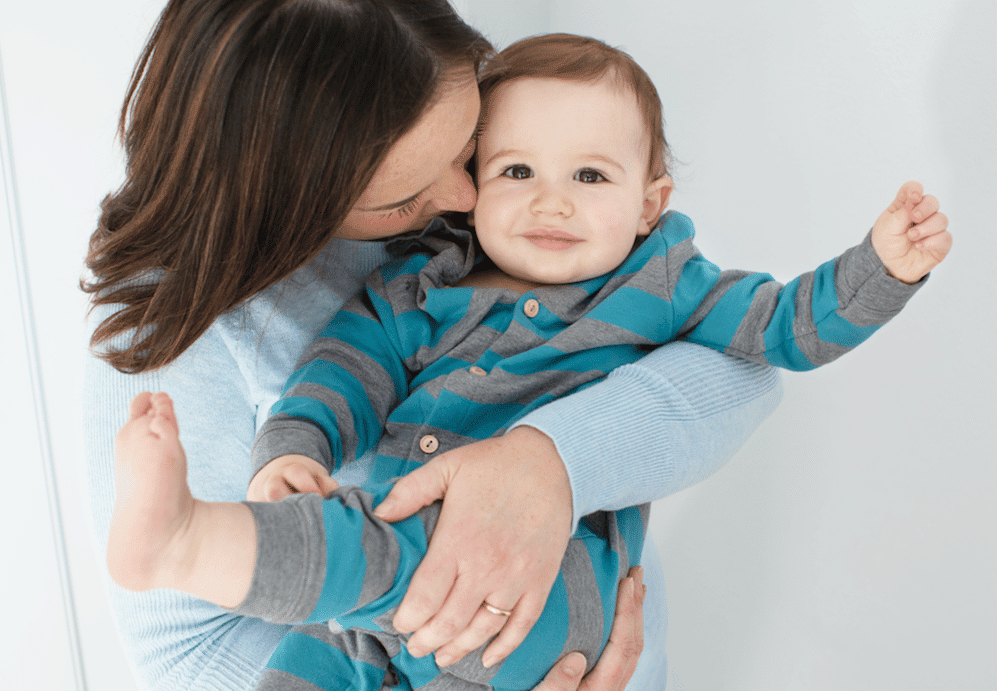3-month-old baby health & growth guide

You’re both officially out of the fourth trimester—and hopefully finding your groove in your new life together.
We independently select and share the products we love—and may receive a commission if you choose to buy.
Table of Contents
It’s been just three short months since baby has arrived earthside, and you’re hopefully finding your groove in your new life together. By now, you’re both officially out of the fourth trimester, feeding is becoming more streamlined, sleep is getting more consistent (fingers crossed!) and your little one is a bit more awake and alert to the world around them, which can make outings more fun (and more manageable). Many babies who experienced colic are now coming out of it, too. There’s still lots of eating, sleeping and pooping happening, of course, but plenty of growing and changing occurring in between. Here’s what to know about your baby’s health and growth in month three.
Related: 3-month-old baby milestones
3-month-old baby nutrition
By 3 months, many feeding challenges seem to resolve and you and your baby may fall into some semblance of a schedule (though all that may go out the window once teething or illness strikes—so sorry to say!). You two have already come so far—and that’s worth shouting out.
Feeding
According to The American Academy of Pediatrics and La Leche League, at 3 months old, babies should be consuming the following amounts at the suggested times below, but remember to follow your baby’s hunger cues. The feeding schedule below is just a suggestion.
How much to feed a 3-month-old baby
Breast milk: 4 to 5 ounces every 3 to 4 hours
Formula: 4 to 5 ounces every 4 hours
Related: 12-week-old feeding schedules and amounts
Common feeding issues: What to know about burping
Because babies have still-developing digestive systems and teeny stomachs, even a small amount of air bubbles can bring major discomfort. Burping after each feeding—or sometimes in between—can help release gas and pressure and make them more comfortable.
The 3 primary burping positions:
- Over your shoulder, with their chin resting on your shoulder
- Sitting up on your lap, while supporting their head and neck
- Tummy down on your lap, while making sure their head is higher than their chest.
In any of these positions, you’ll want to ensure that your baby’s back is straight and flat, not curved. Using a cupped hand, offer repeated gentle pats on their back to help release gas. (Have a burp cloth handy in case spit up makes an appearance.) At 3 months, your baby may not need burping after every feeding, but if they seem fussy after eating, they might need a burp or a position change.
3-month-old baby weight
For babies up to 2 years of age, the Centers for Disease Control and Prevention (CDC) recommend using the World Health Organization (WHO) weight and length charts.
The WHO growth charts for babies 0 to 2 years are based on what is standard for a predominantly breastfed infant. According to the organization, the WHO charts reflect growth patterns among children who were predominantly breastfed for at least 4 months and were still breastfeeding at 12 months. The American Academy of Pediatrics (AAP) recommends continuing to breastfeed for at least two years, as long as it benefits both mother and baby.
Related: AAP recommends breastfeeding for at least 2 years. Here’s how to make that happen
How much does the average 3-month-old weigh?
According to the WHO:
- A 3-month-old baby boy in the 50th percentile weighs 14 pounds (6.4 kilograms)
- A 3-month-old baby girl in the 50th percentile weighs 12 pounds, 14 ounces (5.8 kilograms)
What factors contribute to a 3-month-old baby’s weight?
At this stage, your baby’s weight may be a factor of their birth weight, their assigned sex and how they’re fed.
Size at birth: The weight of your baby at birth will influence their weight now. Babies born preterm may weigh less than babies born full or late term.
Assigned sex at birth: Males tend to gain weight slightly faster than females.
How they’re fed: According to AAP, breastfed babies may gain weight slightly faster than formula-fed babies in the first 6 months of life.
Related: Activities for a 3-month-old: Fostering baby’s development
3-month-old baby length
Between birth and 6 months, babies grow an average of 0.5 to 1 inch each month.
How long is the average 3-month-old?
According to the WHO:
- A 3-month-old baby boy in the 50th percentile is 21.25 inches long (61.4 cm)
- A 3-month-old baby girl in the 50th percentile is 23.5 inches long (59.8 cm)
What factors contribute to a 3-month-old baby’s length?
There are several factors that contribute to your baby’s length in month three. The height of a baby’s parents and other family members strongly influences their future height, as does adequate nutrition during pregnancy and after birth. Finally, boys tend to be slightly longer than girls, and overall health plays a role: chronic disease during childhood can affect future growth and development.
Growth charts and percentiles
At every visit, your child’s pediatrician will plot their weight, length and head circumference on a growth chart. These show how a baby’s weight or length may be compared to the weight or length of other babies of the same age. Growth charts are just one tool used to track a child’s development (along with developmental milestones and feeding and sleep habits), and aren’t meant to be used alone.
How to read a growth chart
If a baby’s weight is in the 55th percentile, it means that 45% of babies of the same age and sex weigh more, and 55% of babies weigh less. Remember, all babies grow at their own pace: healthy babies can be in the 5th percentile as well as the 95th percentile. Overall, your pediatrician is looking for steady and sustained growth, checking the curve of the growth pattern for trends.


Growth spurts
If your little one seems hungrier or fussier lately, it could mean they’re going through a growth spurt. If they jump in weight and/or length, it might slightly change the growth pattern on your child’s growth chart; placing them in a different weight or length percentile. That means their percentile may vary slightly between well-checks, but it’s the dramatic increases or decreases that doctors are especially attuned to.
You might notice a growth spurt right at the beginning of the third month, and it may last anywhere from a few days up to a week. It might be time to size up to 6-month onesies! Packing away your baby’s too-small clothes can be tough (the nostalgia!) but it’s a sign that they’re healthy and growing and ready for bigger things.
Related: Packing away my baby’s clothes is necessary—but it breaks my heart
When should I worry about my baby’s growth?
Your 3-month-old baby is between well-checks right now (the next one happens at 4 months), but if your pediatrician is worried about their growth curve, they likely would have let you know. Otherwise, try not to stress too much: Many factors play a role in your child’s development, including weight, length, head circumference and developmental milestones.
If you’re concerned about your baby’s growth, your child’s pediatrician will likely ask about the following factors:
- The number of feedings per day
- How much your baby takes in at each feeding (approximately), or how long they feed for, if breastfeeding
- How many times your baby poops in a day, and what their stool looks like
3-month-old baby sleep
Your 3-month-old is no longer considered a newborn now, and they need slightly less sleep than they did in the months prior. Still, your 3-month-old baby should still be aiming for 12 to 16 hours of sleep per 24 hours, according to the American Academy of Sleep Medicine.
Aim for 10 to 12 hours of consolidated night sleep, and make up the rest in a series of daytime naps. You can likely still expect one to two nighttime feedings, but they’re starting to get the hang of sleeping in longer periods, which hopefully means you are, too.
What baby sleep looks like at 3 months:
- Your baby may be taking 3 to 4 naps per day
- Your baby may be sleeping in 3- to 6-hour windows at night
- Your baby may be awake for 60 minutes to 90 minutes at a time, or even 120 minutes between their last nap and bedtime
Read more: How much sleep does a 12-week-old baby need?
Diapering a 3-month old
Wondering how often a 3-month-old baby poops? Know that there’s a pretty wide range of normal in the diaper department. Most babies will poop one or more times per day, but it can also be normal to skip up to two days as long as the consistency stays the same.
For breastfed babies, stool should be soft and slightly runny. For formula-fed babies, stool should be paste-like and slightly firmer, but not hard. If your baby has hard, formed or pellet-like stools, call your pediatrician, as it may be a sign of constipation.
Diaper rash is still fairly common in 3-month-old babies (don’t forget to stash some diaper rash cream in your diaper bag for outings, and even a backup tube in your car could be helpful). You could also try expressing a little breast milk to apply directly to the affected area—studies show it’s just as effective as cortisone cream.
Caring for a 3-month-old
Aside from diaper rash, cradle cap and colds are other common ailments to watch for at 3 months.
Cradle cap
Cradle cap is most likely to affect babies around 3 months and younger, but it can last up to a year. Wash baby’s hair with a gentle shampoo, and then use a soft-bristled brush or washcloth to gently remove the scales. They’re harmless—you can also just let them be!
Colds and illnesses
If your baby has a cold, they might have a slightly runny nose, a mild fever, and/or may be more tired or fussy than normal. Colds can make it difficult to feed, so try using a humidifier near where baby’s eating, or consider running the shower on full power and making a pseudo steam room in the bathroom to help clear baby’s airways before feeding. Saline spray can also help ease stuffy nasal passages.
Baths
At 3 months, your baby won’t need a daily bath, but it can be a calming part of their nighttime routine if that works for your family. No need to use soap—too much soap can be drying for their sensitive skin. Warm, clean water should suffice, but if you want to combat cradle cap, a gentle baby shampoo can help.
Drooling
Drooling might start around 3 months, but it doesn’t necessarily mean that their first teeth are right around the corner. Drooling becomes much more heightened between now and when they turn 6 months old, so get ready for more spit. (Enter: cute bibs!) But know that saliva serves a few big biological functions for your baby, including supporting digestion, keeping (future) teeth clean and making it easier to swallow.
Note, however, that if your little one is suddenly drooling, can’t make sounds and is having trouble breathing, they could be choking—call 911 immediately.
Safety concerns
Now that your 3-month-old is getting stronger and more alert, it’s a good time to brush up on infant safety basics.
Bath safety
The cardinal rule of bath time is to never leave baby unattended, even for a second, which means you’ll want to prep everything you might need before you place baby in the water. A sink bath with a tub insert may be perfectly fine for your 3-month-old, but the FDA warns agains using infant neck floats.
Preeti Parikh, MD, pediatrician and GoodRx executive medical director, doesn’t recommend parents use an infant bath seat, which is nestled inside an adult bath tub.
“This item, which is supposed to help an infant to sit upright in a tub, can flip backwards which can cause the child to drown,” she says. An in-sink baby bath tub may be safer until baby gets a bit bigger. Keep baths short, to no more than 10 minutes, and lift slippery babies with extra care.
Related: 14 bath safety tips for babies and kids of all ages
Safe sleep
Babies should always be placed on their backs for sleep on a flat surface with only a fitted sheet, AAP notes, for both naps and nighttime sleeping. Remove any loose swaddles, blankets or toys from their sleep space, and aim to keep the room on the cooler side. Read up on the AAP’s latest sleep safety guidelines to minimize the risk of sudden infant death syndrome (SIDS), which can be elevated until baby turns 1, but is highest in the first 6 months.
Related: 14 science-backed ways to reduce SIDS risk in babies
Car seat safety
While your baby should be buckled into a rear-facing infant car seat for every drive, once you get to your destination, try not to let them sleep in their car seats outside of the car. Doing so can cause heavy, sleeping heads to restrict air flow. Loose straps could prove hazardous, too—check that they’re snug, and remove any thick coats before buckling. The ‘inch test’ is a good way to check strap snugness.
How to do the inch test:
- Grasp the car seat near the belt path (the area when the seat belt or lower anchor strap runs through the car seat) and give it a firm tug.
- The car seat should not move more than 1 inch from side to side or front to back.
- If it does, repeat the steps to tighten the car seat until movement is less than 1 inch.
Related: A parent’s guide to car seat safety: Tips, rules & product picks
Burns
From sunburns to scalds, babies’ sensitive skin can be highly susceptible to burns. Check your home’s hot water heater temperature—lowering to 120 degrees Fahrenheit is the safest bet. Around 100 degrees Fahrenheit is recommended for a comfortable bath, which will feel warm (not hot) on your wrist. And remember to keep hot liquids, like your morning coffee, out of their tiny arm’s reach. For outings, because babies under 6 months shouldn’t wear sunscreen, keep them covered but cool in sun hats and lightweight clothing.
Bumps and falls
Babies wiggle—especially as they work on tummy time and rolling over. Avoid leaving your little one unattended on any type of elevated surface, like a changing table, bed or couch, which could result in an accidental fall or bump.
Choking hazards
As your little one works on moving things to their mouth for exploration, keep an eye on what’s within grabbing distance. Coins, bottle caps and button batteries are common non-food items that can pose as choking hazards.
Related: This toddler swallowed a button battery—her mom says ingesting honey helped save her life
A note from Motherly on self-care while caring for a 3-month-old
How does it feel to be past the fourth trimester? We’d be remiss in not celebrating this milestone for what it is—the start of a new chapter. Hitting the 12-week mark doesn’t mean that things will magically get easier, but it may mean that you’ve now had time to recover from birth, found your groove with feeding your growing little one and are hopefully getting more sleep for yourself.
But taking moments of rest is still so important when you’re caring for a baby, and if you find you’re not able to get the rest you need, it’s time to see where you can receive extra help. Can you switch to grocery delivery? Ask a friend or family member to come visit and play with baby while you do absolutely nothing for an hour? Get older kids to help with laundry? There are people out there who want to help you, mama. You just might have to ask.
And if you feel like you’re struggling more than you’re used to, reach out to a mental health expert, who can help address your symptoms. Postpartum depression (PPD) can set in anytime in the first year after birth.
Related: 4-month-old baby health & growth guide
Postpartum mental health resources
If you’re experiencing any postpartum mood symptoms, no matter how mild, know that help is available. Reach out to your healthcare provider about next steps and potential treatment options, such as more support at home, therapy or medication. If you’re in crisis, reach out to a crisis hotline or dial 988 or 911 for immediate support.
The phone numbers listed below are available 24/7 to help you with suicidal thoughts or other mental health crises.
- The National Maternal Mental Health Hotline: 1-833-TLC-MAMA (1-833-852-6262)
- Available in English and Spanish and in a completely confidential line.
- Postpartum Support International: 1-800-944-4773 (call or text)
- Available in English and Spanish
- National Crisis Text Line: Text HOME to 741741
- National Suicide Prevention Hotline: Call or text 988
- Available in English and Spanish
A version of this story was originally published on March 22, 2023. It has been updated.















































